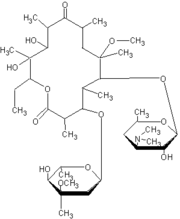

The macrolides are a group of drugs (typically antibiotics) whose activity stems from the presence of a macrolide ring, a large lactone ring to which one or more deoxy sugars, usually cladinose and desosamine, are attached. The lactone ring can be either 14, 15 or 16-membered. Macrolides belong to the polyketide class of natural products.
Contents |
Members
Commonly prescribed Macrolides
- erythromycin
- azithromycin (Zithromax®)
- clarithromycin (Biaxin®)
- dirithromycin (Dynabac®)
- roxithromycin (Rulid®, Surlid®)
Developmental Macrolides
- carbomycin A
josamycin
kitasamycin
oleandomycin
spiramycin
troleandomycin
tylosin/tylocine (Tylan®)
Ketolides
Ketolides are a new class of antibiotics that are structurally related to the macrolides. They are used to fight respiratory tract infections caused by macrolide-resistant bacteria.
- telithromycin (Ketek®)
cethromycin
Others are: spiramycin (used for treating toxoplasmosis), ansamycin, oleandomycin, carbomycin and tylocine.
Non-antibiotic macrolides
The drug Tacrolimus, which is used as an immunosuppressant, is also a macrolide. It has similar activity to cyclosporin.
Toxic macrolide
- mycolactone
Uses
Macrolides are used to treat infections such as respiratory tract infections and soft tissue infections. The antimicrobial spectrum of macrolides is slightly wider than that of penicillin, and therefore macrolides are a common substitute for patients with a penicillin allergy. Beta-hemolytic streptococci, pneumococci, staphylococci and enterococci are usually susceptible to macrolides. Unlike penicillin, macrolides have been shown to be effective against mycoplasma, mycobacteria, some rickettsia and chlamydia.
Mechanism of action
The mechanism of action of the macrolides is inhibition of bacterial protein synthesis by binding reversibly to the subunit 50S of the bacterial ribosome, thereby inhibiting translocation of peptidyl-tRNA. This action is mainly bacteriostatic, but can also be bactericidal in high concentrations. Macrolides tend to accumulate within leukocytes, and are therefore actually transported into the site of infection.
- A novel, non-antibiotic, anti-inflammatory effect of 14-membered macrolides was discovered in Japan(Kudo S. et al.), which is especially effective in improving control of diffuse panbronchiolitis(DPB). Research on the anti-inflammatory properties of the macrolide ring is ongoing.
Resistance
The primary means of bacterial resistance to macrolides occurs by post-transcriptional methylation of the of the 23S bacterial ribosome. This acquired resistance can be either plasmid-mediated or chromosomal, i.e through mutation, and results in cross-resistance to macrolides, lincosamides, and streptogramins (an MLS-resistant phenotype).
Two other types of acquired resistance rarely seen include the production of drug-inactivating enzymes (esterases or kinases) as well as the production of active ATP-dependent efflux proteins that transport the drug outside of the cell.
External links
- Macrolides with extended spectrum "Family Practice Notebook" page for macrolides with extended spectrum
- Antibiotics bound to the 50S subunit Riboworld on the 50S ribosome and antibiotics
- Structure Activity Relationships "Antibacterial Agents; Structure Activity Relationships," André Bryskier MD; beginning at pp143




 216.73.216.81
216.73.216.81 User Stats:
User Stats:
 Today: 0
Today: 0 Yesterday: 0
Yesterday: 0 This Month: 0
This Month: 0 This Year: 0
This Year: 0 Total Users: 117
Total Users: 117 New Members:
New Members:
 216.73.xxx.xx
216.73.xxx.xx
 Server Time:
Server Time:
